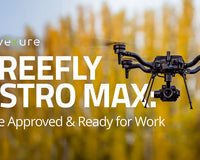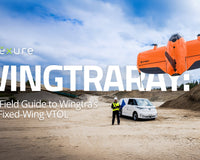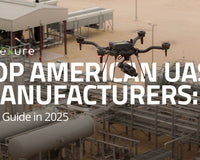You're driving across a massive suspension bridge during your morning commute. The sun glints off the steel beams as cars rush by in both directions. But in the back of your mind, a random thought—how safe is this bridge? When was it last inspected?
You may not think about it, but for the inspectors responsible for our nation’s aging infrastructure, these questions are at the forefront every day.
Beneath the surface, cracks, corrosion, or structural wear could be slowly weakening what once seemed solid. Inspecting these vital structures has traditionally required long hours, high costs, and even dangerous conditions. But now, thanks to advancements in drone technology, the way we assess and maintain critical infrastructure is being transformed—faster, safer, and with unmatched precision.
The Infrastructure Crisis – A Ticking Time Bomb
The state of America’s infrastructure is a growing concern, with millions of people relying on aging bridges, roads, and power lines every day. According to the American Society of Civil Engineers (ASCE) 2021 Infrastructure Report Card, 42% of all U.S. bridges are at least 50 years old. Of the 617,000 bridges across the country, a staggering 231,000 need repair or preservation work, with 46,154 classified as structurally deficient and in poor condition. Every day, 178 million trips are taken over these structurally deficient bridges, placing lives and property at risk.

Traditional inspection methods—requiring snooper trucks, scaffolding, or even inspectors rappelling from heights—are not only time-consuming and expensive, but they also pose significant safety risks for workers. Inspecting just one bridge can cost thousands of dollars and take days to complete, creating a strain on both budgets and resources. Moreover, these methods often involve shutting down roads, contributing to traffic delays and environmental impact.
The need for a more efficient, cost-effective, and safer approach to infrastructure inspections is evident.
The High Cost of Traditional Inspections
Inspecting critical infrastructure—whether bridges, power lines, or pipelines—using traditional methods can be costly, inefficient, and risky.
1. Expensive
Manual inspections come with high costs. According to the Federal Highway Administration (FHWA), traditional bridge inspections using snooper trucks or scaffolding can cost upwards of $4,600 per bridge . For large infrastructure systems, these costs quickly escalate, straining budgets for public agencies and utilities. Additionally, manual inspections often involve road closures or traffic disruptions, adding indirect economic impacts to local communities and transportation networks .
2. Unsafe
Traditional inspections pose significant safety risks to workers. Inspectors are often required to rappel down bridges or work near high-voltage power lines, exposing them to potential accidents and hazardous conditions. A report from OSHA highlights the dangers of working at heights or in confined spaces, which are common during infrastructure inspections .
3. Inefficient
Manual inspections are time-consuming. It can take an entire day to inspect a single bridge, requiring multiple workers and specialized equipment. The FHWA reports that traditional inspections of infrastructure like power lines or pipelines can take days, leading to delays in identifying and addressing critical issues . The logistical challenges, combined with the high cost and labor, mean many inspections are postponed or only performed when absolutely necessary, leaving potential risks undetected.
As infrastructure continues to age, the need for faster, safer, and more efficient inspection methods is clear

Drones – A New Era of Inspections
Drones are rapidly changing how critical infrastructure is inspected, offering faster, safer, and more cost-effective solutions.
1. Efficiency
UAS drastically reduces the time required for inspections. According to the Michigan Department of Transportation (MDOT), a typical drone bridge inspection can be completed in two hours with just two people, compared to traditional methods that require four people and eight hours . This efficiency is not limited to bridges; drones can cover large sections of power lines, pipelines, or railroads in a fraction of the time it takes manual teams.
2. Improved Data Collection
Drones collect more precise and comprehensive data than manual inspections. High-resolution cameras, LiDAR, and thermal imaging allow drones to capture defects or changes in infrastructure that are difficult to detect through traditional means. A study by the American Society of Civil Engineers (ASCE) showed that drones could capture 3D models and high-definition images, enabling asset managers to detect cracks, corrosion, and other structural issues.
3. Safety
According to the American Society of Mechanical Engineers (ASME), drone inspections reduce worker exposure to hazardous environments, lowering the risk of accidents by up to 91% . Inspecting dangerous infrastructure like high bridges or power lines no longer requires personnel to be in harm’s way, which reduces injury rates and protects workers.
4. Cost Savings
Drone inspections offer considerable cost savings. The American Association of State Highway and Transportation Officials (AASHTO) reported that using drones can reduce inspection costs by 74% . For example, a traditional bridge inspection costing $4,600 can drop to around $250 with drones . States like North Carolina and Michigan have reported millions of dollars in projected savings by integrating drones into their inspection processes .
Real-World Applications of Drone Inspections
- Bridge Inspections: State Departments of Transportation across the U.S. are using drones to safely inspect bridges in less time. These drones capture high-resolution images of hard-to-reach areas, allowing inspectors to detect structural issues without the need for costly equipment or road closures.
- Power Line Monitoring: Utilities are deploying drones to inspect power lines, especially in remote or hazardous areas. Drones can quickly cover long distances, identifying damage or wear that may lead to outages, all while minimizing risks to human workers.
- Pipeline Inspections: Drones are also used to monitor pipelines, identifying leaks, corrosion, or damage over vast stretches of terrain. This reduces the need for manual checks, which are slower and more expensive.
Top Drone Recommendations for Infrastructure Inspections
When it comes to inspecting critical infrastructure like bridges, power lines, and pipelines, signal interference caused by metal structures is a key concern. Metal reflects and absorbs radio frequencies, which can lead to loss of communication between the drone and its controller. The following drones are equipped with advanced systems to mitigate these issues, ensuring precise and reliable inspections.
- Multirotor Drones
For close-up inspections of infrastructure like bridges, buildings, and utility towers, multirotor drones are the go-to option for their maneuverability and data collection capabilities. Here are some of Advexure’s top picks:
- DJI Matrice 30: Compact yet powerful, the Matrice 30 features a high-quality sensor payload, including a wide-angle camera, zoom camera, and laser rangefinder, enabling high-resolution imagery from multiple angles. Its IP54-rated durability makes it perfect for harsh environments, while compatibility with DJI FlightHub 2 and the DJI Dock enhances operational efficiency. Whether you're inspecting bridges or tall structures, the Matrice 30 delivers reliable performance with superior image capture.
- DJI Matrice 350 RTK with Zenmuse L2/P1: A next-generation drone platform with advanced RTK positioning, the Matrice 350 RTK provides industry-leading data accuracy. It boasts a 55-minute flight time, IP55 protection, and an upgraded OcuSync 3 transmission system, making it ideal for large-scale infrastructure projects. Paired with the Zenmuse P1 (45 MP camera), it excels in photogrammetry and aerial surveying. For LiDAR applications, the Zenmuse L2 payload offers superior penetration, with a detection range of 250-450 meters and vertical accuracy of 4 cm.
- DJI Mavic 3 Enterprise with RTK Module: This drone is perfect for mapping, surveying, and smaller inspection tasks, with a 4/3" CMOS 20MP camera and mechanical shutter for high-precision images. Its optional RTK module provides centimeter-level accuracy, making it ideal for infrastructure assessments where precision is key. With up to 45 minutes of flight time, the Mavic 3 Enterprise is a quick-to-deploy solution for on-the-go inspections.
- Autel EVO Max 4N: Designed for nighttime operations, the EVO Max 4N is equipped with starlight night vision and thermal cameras, making it ideal for low-light inspections, such as during emergency responses or power outages. Its 720-degree obstacle avoidance and laser ranging capabilities ensure safe navigation in complex environments, while the high-precision sensors capture critical data in difficult conditions.
- Autel EVO II Enterprise V3 with RTK Module: This versatile drone offers a 6K camera and thermal imaging, making it ideal for power line and pipeline inspections. The RTK module provides centimeter-level precision, essential for infrastructure mapping and monitoring. With up to 40 minutes of flight time, the EVO II Enterprise V3 is built for endurance and high-definition data collection.
- DJI Avata 2 (For Covered Bridges): The DJI Avata 2 is a great option for inspecting covered bridges, where limited GNSS signals are often a concern. With built-in low-latency HD transmission and enhanced stability features, the Avata 2 is well-suited for enclosed environments.
2. Dock-Based Drone Solutions
For continuous or scheduled inspections, dock-based drones offer a hands-off, automated solution. These systems allow drones to operate independently, providing regular monitoring without the need for constant human intervention.
- DJI Dock 2 redefines remote operations with a lightweight, compact design that’s 68% lighter and 75% smaller than its predecessor, making transport and setup more efficient. Equipped with dual RTK antennas for precise positioning and internal/external cameras for enhanced environmental awareness, Dock 2 supports quick, safe, and automated missions. Combined with the DJI Matrice 3D—which features a 4/3 CMOS wide camera, a tele camera, and a 50-minute flight time—this system excels in high-precision mapping tasks, making it ideal for large infrastructure projects that require frequent monitoring. The Matrice 3D's IP54 rating ensures reliable performance even in harsh conditions, while 6-directional obstacle sensing enhances flight safety.
-
Omnidock from Counterdrone is a versatile, drone-agnostic docking station that supports a wide range of UAVs, making it a flexible solution for autonomous operations. Its configurable floors allow for housing various drone sizes, including the DJI Matrice series or two smaller DJI Mavic-sized drones. Designed for easy integration, Omnidock works seamlessly with fleet management applications like VOTIX to support fully autonomous missions. Its weatherproof, hemispherical design provides excellent wind and weather resistance, making it suitable for various climates. The OmniDock can be deployed for multiple critical services, such as public safety, inspection, and security, and it can be upgraded to accommodate future drone models, ensuring long-term adaptability.
The Future of Infrastructure Inspections
The future of drone inspections is being shaped by advancements in automation, artificial intelligence, and data analysis. Autonomous drones, like those in dock-based systems, can perform regular, scheduled inspections without human intervention.
AI-powered analysis further enhances inspection accuracy by detecting structural issues such as cracks or corrosion in real-time. With these technologies, drones are not only transforming inspections today but are paving the way for a future of continuous, efficient monitoring.
At Advexure, we understand the challenges infrastructure managers face. Our team of subject matter experts is ready to help you find the best UAS solutions for your specific inspection needs. Whether you're looking to enhance safety, reduce costs, or improve data accuracy, we’re here to support you every step of the way.
Reach out to our team today to learn how drone technology can transform your infrastructure inspections.










